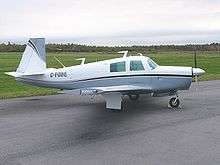Skywest Airlines Flight 1834
| Accident summary | |
|---|---|
| Date | January 15, 1987 |
| Summary | Mid-air collision caused by pilot error on Mooney M-20 aircraft |
| Site | near South Valley Regional Airport, Salt Lake City, Utah, United States |
| Total fatalities | 10 (all) |
| Total survivors | 0 |
| First aircraft | |
.jpg) Swearingen SA226TC Metro II similar to accident aircraft | |
| Type | Swearingen SA226-TC Metro II |
| Operator | SkyWest Airlines |
| Registration | N163SW[1] |
| Flight origin | Pocatello Airport |
| Destination | Salt Lake City International Airport |
| Passengers | 6 |
| Crew | 2 |
| Survivors | 0 |
| Second aircraft | |
 MooneyM20C similar to accident aircraft | |
| Type | Mooney M-20 |
| Operator | private |
| Registration | N6485U[2] |
| Passengers | 0 |
| Crew | 2 |
| Survivors | 0 |
On January 15, 1987, at 12:52 local time, SkyWest Airlines Flight 1834 a Swearingen SA-226TC (METRO II), and a Mooney M20 were involved in a midair collision near Kearns, Utah. The two pilots and six passengers aboard the METRO II and the two pilots aboard the Mooney were killed.
Collision
The SkyWest Airlines aircraft, which was 30 minutes late, was on final approach to Runway 34 of Salt Lake City International Airport when the collision occurred. The Mooney M-20 had just taken off from South Valley Regional Airport and had two crew, a pilot and a student pilot. The aircraft collided in midair and fell to the ground. Bodies were scattered over a one-mile-square area. A temporary morgue was set up at a nearby church to identify the victims of the disaster. The main section of the SkyWest Airlines aircraft came to rest in the middle of a suburban street after sliding through a chain-link fence. Many people reported hearing a "big boom" and then "parts were flying everywhere". In a later interview, the air traffic controller on duty claimed that the SkyWest Airlines aircraft was initiating a 90-degree turn when the collision occurred.[3][4]
Investigation
The investigation into this accident ultimately blamed the Mooney M-20 instructor pilot for straying into the Salt Lake City airport radar service area. The investigation also criticised the lack of a Mode-C transponder and the limitations of air traffic control collision protection.[5]
See also
- Aeromexico Flight 498 another collision between a private aircraft and a commercial airliner.
- PSA Flight 182
References
- ↑ "FAA Registry". Federal Aviation Administration.
- ↑ "FAA Registry". Federal Aviation Administration.
- ↑ ASN Aircraft Accident Swearingen Metroliner, Kearns, UT
- ↑ 2 AIRPLANES COLLIDE OVER UTAH | NYTIMES.COM
- ↑ Official NTSB report into SkyWest Airlines Flight 1834